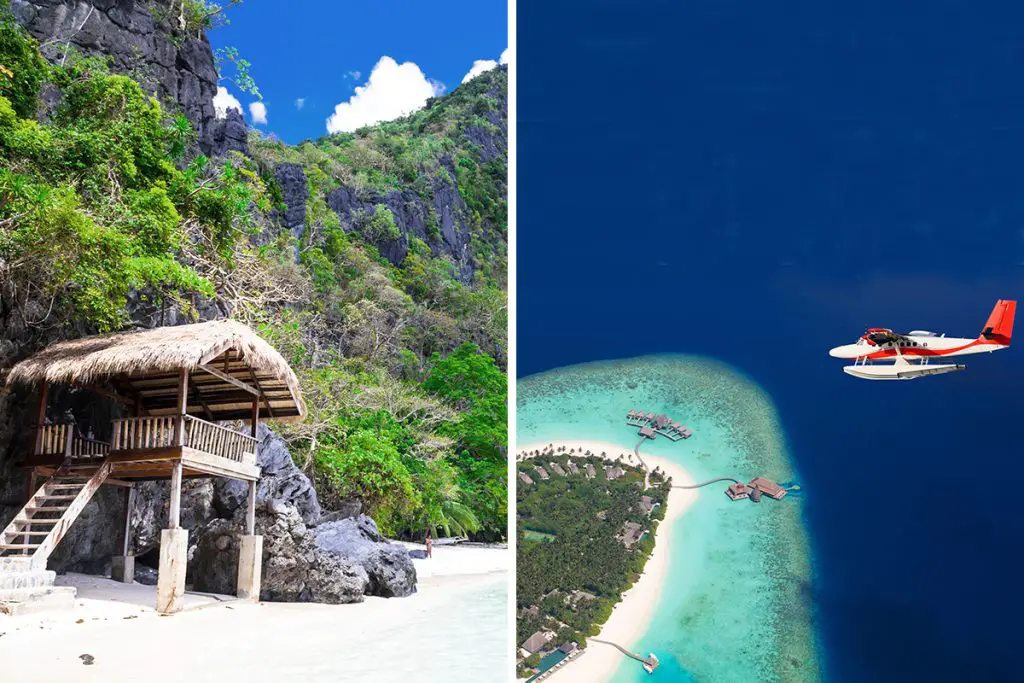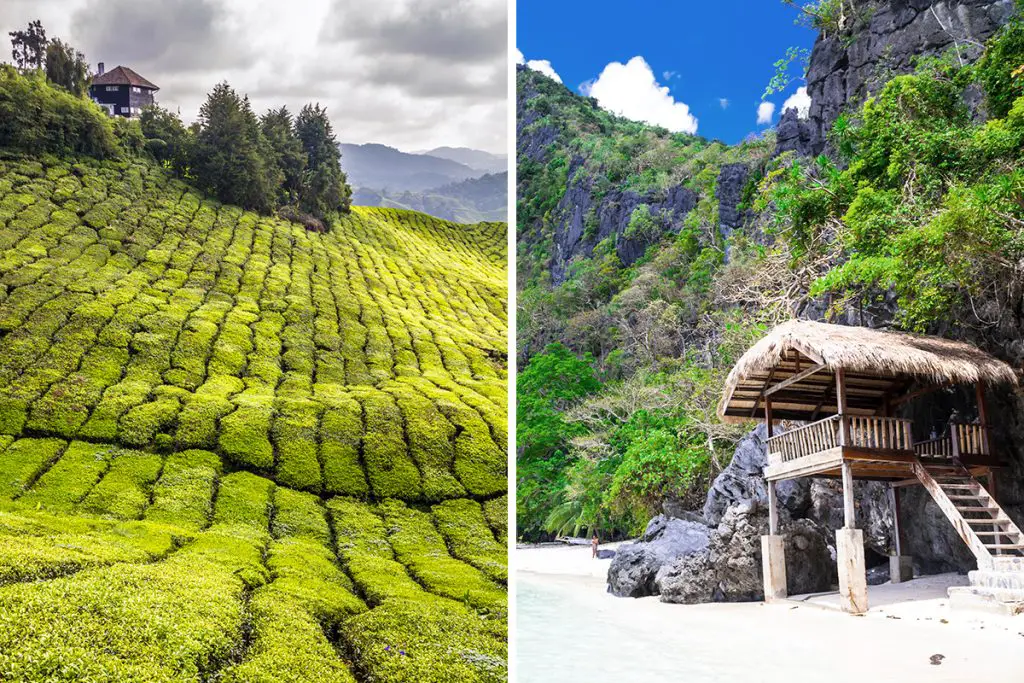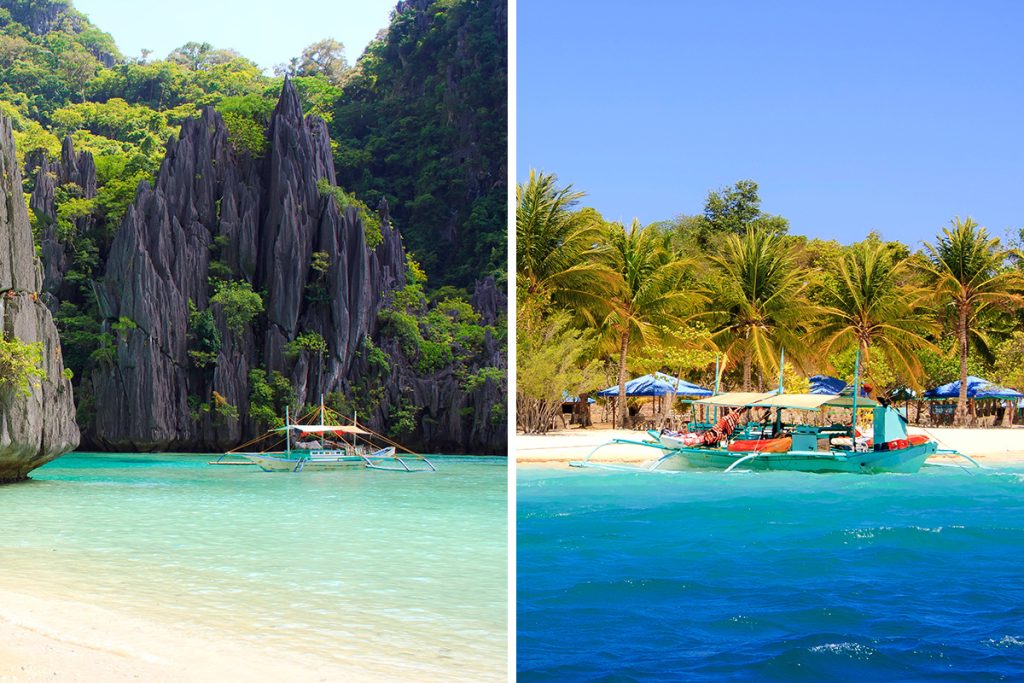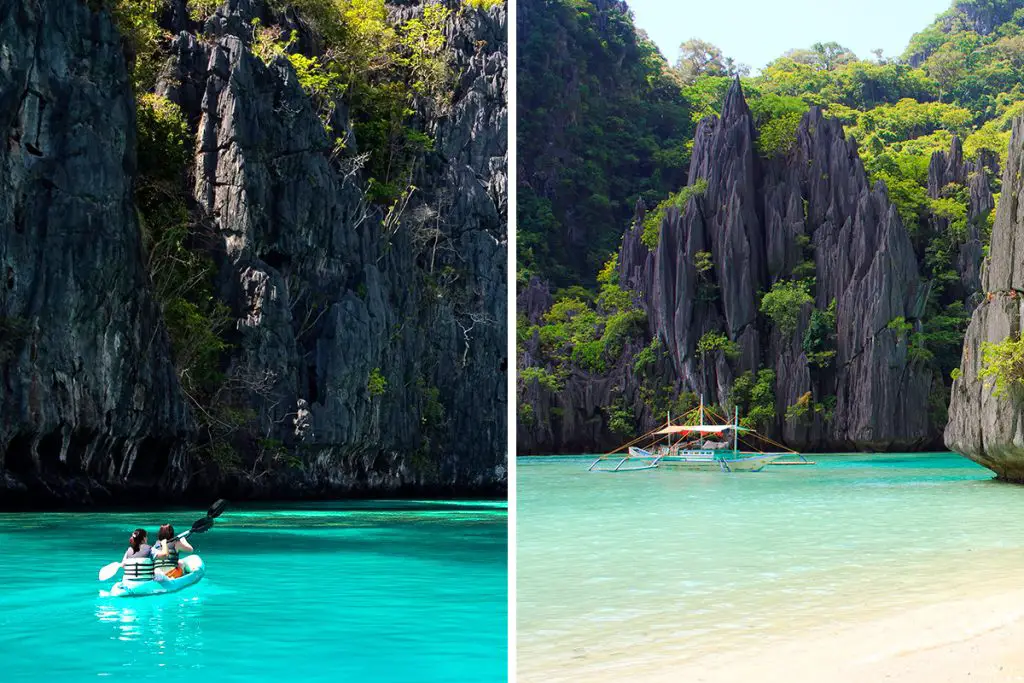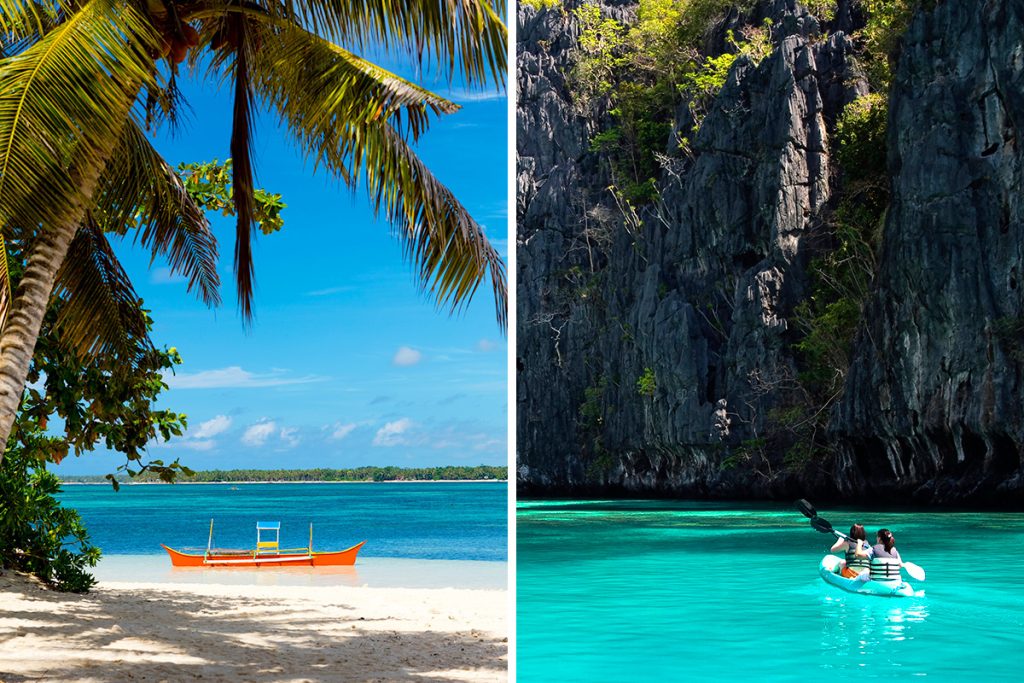Are you feeling the itch to pack your bags, but still can’t make up your mind? The pull of history, the allure of different cultures, the very spirit of a place – these can help tip the scales. Ready to discover more and settle that Cebu versus Palawan conundrum?
History & Culture
Diving into the history and culture of a place is like peeling an onion – there’s always more to discover beneath the surface. And when it comes to Cebu and Palawan, each layer offers a new understanding, a fresh perspective.
Cebu, the oldest city in the Philippines, holds a rich tapestry of historical moments. From being a buzzing trade hub in the pre-colonial period to witnessing the first Catholic mass on the island, Cebu stands as a testament to time. It is where East meets West, with cultural imprints of Spain, China, and the United States, all mingling with the indomitable Filipino spirit.
There’s a lively rhythm to Cebu, a pulse that syncs with its historical narrative and shapes its modern identity.
Palawan, on the other hand, is a bit of a mystery. Its history is not as well-documented as Cebu’s, but that’s what makes it intriguing. Its strategic location once made it a pivotal point for seafaring merchants and colonial powers.
But what truly sets Palawan apart is its indigenous cultures, like the Palaw’an and the Tagbanwa. Their age-old traditions, tales, and practices are woven into the fabric of this island paradise.
So, are you drawn to the vibrancy and rich past of Cebu, or does the enigmatic and culturally diverse Palawan captivate your curiosity more? Each destination offers a window into different aspects of Filipino history and culture, presenting you with two unique stories to explore.
Whether you’re a history buff or someone seeking to immerse yourself in a different culture, the choice between Cebu and Palawan is a ticket to a journey steeped in the past and brimming with enriching experiences. So, which story resonates with you the most? The tale is yours to choose.
Attractions & Activities
A travel destination is like a treasure box of experiences, waiting to be opened. But what’s inside? Well, for Cebu and Palawan, the treasures are their countless attractions and activities that leave one awestruck.
Starting with Cebu, the city is a gateway to a world of diverse experiences. One of its crowning jewels is the Basilica Minore del Santo Niño, a centuries-old church housing a revered statue of Christ as a child. If you fancy a step back in time, visit Fort San Pedro, a military defense structure from the Spanish colonial era.
An escape into nature? The stunning Kawasan Falls is just a bus ride away. If you’re after a breathtaking view, don’t miss Tops Lookout, a hilltop vista offering panoramic views of Cebu City.
Palawan, while more known for its natural beauty, also offers a wealth of attractions. For a peek into Palawan’s history, the Palawan Museum is a must-visit.
Adventure seekers can explore the Puerto Princesa Subterranean River National Park, a UNESCO World Heritage site with an underground river. If you’re into wildlife, a trip to the Calauit Safari Park, home to various African and endemic species, is an absolute must.
So, how do you like your adventure? Do you lean towards historical and city exploration like in Cebu, or does the call of nature and wildlife in Palawan lure you in? Both destinations offer distinctive activities, each promising an unforgettable experience.
Beaches
A tropical vacation would be incomplete without basking in the sun-kissed beaches, wouldn’t it? Both Cebu and Palawan are blessed with stretches of sand that redefine beauty.
Cebu’s coastline is dotted with beaches that are as beautiful as they are diverse.
From the white sands of Bantayan Island to the unique sable shores of Moalboal, Cebu’s beaches are like a painter’s palette, offering a color for every mood. It’s a journey of about 80 miles (128 kilometers) from the city to Bantayan, while Moalboal lies approximately 60 miles (96 kilometers) away.
On the other hand, Palawan’s beaches are a world unto themselves. The island of El Nido alone, located around 238 miles (383 kilometers) from Puerto Princesa, boasts multiple pristine beaches. Then there are the serene shores of Coron, about 202 miles (325 kilometers) away, with turquoise waters set against towering limestone cliffs.
So, where do you see yourself dipping your toes? In the multicolored sands of Cebu or the untouched beauty of Palawan’s beaches? Either way, you are in for a treat. Choosing between Cebu and Palawan is like picking your preferred shade of paradise. So, which color of beachside bliss catches your eye?
Eating, Drinking & Nightlife
Immersing oneself in the local cuisine, sipping on exotic beverages, and dipping into the nightlife are vital elements of the travel experience. Let’s see how Cebu and Palawan play their parts in this gastronomic and social symphony.
Starting with Cebu, the city is a veritable food paradise. It is famous for its Lechon – a whole roasted pig that has been marinated and cooked over an open fire. On the other hand, “pusô,” or hanging rice, is a quirky culinary delight unique to Cebu.
When it comes to drinks, Cebu offers a mix of local and global flavors. You can enjoy a bottle of Tuba, a traditional Filipino coconut wine, or sip on world-class brews at the city’s many craft beer pubs.
Nightlife in Cebu is vibrant, with a plethora of nightclubs, music lounges, and rooftop bars where you can dance the night away or simply enjoy the city lights with a cocktail in hand.
Palawan, while quieter, provides its unique flavors. Seafood is king here, with restaurants serving up fresh catches daily. Unique local dishes such as Tamilok, a woodworm usually served raw, provide a memorable culinary experience.
For drinks, why not try Lambanog? This local coconut vodka is a must-try when in Palawan. There are also numerous beachfront bars where you can sip your drink while enjoying the sunset.
Nightlife in Palawan is more laid-back compared to Cebu. Think beach bonfires, acoustic bands, and starry skies. It’s a different flavor of fun, more in sync with the island’s serene vibe.
Are you more enticed by the vibrant and diverse food, drink, and nightlife scene of Cebu, or does the relaxed, beachfront charm of Palawan seem more appealing? Both provide their own distinct culinary and social experiences.
Shopping
A travel experience wouldn’t be complete without bringing home a piece of the destination, right? Cebu and Palawan offer unique shopping experiences that cater to every traveler’s tastes.
In Cebu, you’ll find a blend of modern malls and traditional markets. Ayala Center Cebu and SM City Cebu are teeming with local and international brands. However, if you’re looking for more traditional items, the Carbon Market offers everything from local crafts to fresh produce.
Cebu is also renowned for its quality furniture and home decor, so don’t miss out on exploring export overruns in furniture shops around the city. For fashionistas, locally made accessories and clothing items from Islands Souvenirs are must-buys.
Palawan, in contrast, is your go-to for handmade crafts and pearls. The public market in Puerto Princesa is a treasure trove of native products, from woven mats to wooden sculptures. Meanwhile, the city’s pearl shops offer stunning South Sea pearls, perfect for a keepsake or gift.
Is it the bustling markets and modern malls of Cebu that catch your fancy, or do the handicrafts and pearls of Palawan make your heart skip a beat? Whichever you choose, you’re sure to find something that will remind you of your Philippine adventure.
Accommodation
A comfortable place to rest is a key part of any trip. Both Cebu and Palawan offer an array of accommodations that cater to different preferences.
In Cebu, you’ll find a wide range of options, from luxury hotels to budget-friendly guesthouses. High-end options include the five-star Crimson Resort and Spa Mactan and the Radisson Blu Cebu located near the city center. For those on a tighter budget, guesthouses and dormitory-style accommodations are plentiful.
Palawan, on the other hand, offers a more rustic experience. Luxury resorts like the El Nido Resorts on private islands offer a premium getaway. But if you’re after something closer to nature and budget-friendly, consider staying in one of the many eco-lodges or homestays available.
Both destinations offer a mix of luxury and budget options, but the choice between Cebu’s city-style accommodation and Palawan’s nature-oriented lodging could make all the difference in your trip.
Family-Friendliness & Children’s Activities
Making memories with the family is one of the best parts of travel. But which between Cebu and Palawan offers the best for families and children?
Cebu is packed with family-friendly activities. You could visit the Cebu Ocean Park, the largest oceanarium in the Philippines. For a combination of fun and learning, the Jumalon Butterfly Sanctuary is a hit with kids. There’s also Mountain View Nature’s Park, a great place for family picnics.
Palawan also offers plenty for families. The Palawan Butterfly Eco-Garden and Tribal Village is an educational and enjoyable outing. Kids will surely love the Palawan Wildlife Rescue and Conservation Center, where they can see crocodiles up close. For older kids, Ugong Rock Adventures offers exciting activities like zip-lining and spelunking.
Whether it’s the varied city attractions of Cebu or the natural experiences of Palawan, both are promising picks for a memorable family trip.
Getting There & Getting Around
Traveling to and exploring a new destination is part of the adventure. So, how do Cebu and Palawan fare in this aspect?
Reaching Cebu is easy, thanks to the Mactan-Cebu International Airport, the second busiest airport in the Philippines, with numerous domestic and international flights. Once in the city, getting around is simple, with options like taxis, jeepneys, and Grab (the local equivalent of Uber).
Palawan can be reached by flying into Puerto Princesa International Airport, with connections from various cities in the Philippines. From there, you might need to take a van or ferry to reach other parts of the island. Moving around in Palawan is generally via tricycles, vans, and boats for island hopping.
Whether you prefer the ease of Cebu’s city transport or the more adventurous modes in Palawan, getting to and around both destinations is part of the journey. So, which kind of travel journey suits you best?
Weather
The climate can make or break your holiday, so knowing the weather patterns of your chosen destination is crucial. So, what’s the weather like in Cebu and Palawan?
Cebu has a tropical climate with temperatures typically ranging between 75-90°F (24-32°C). There’s a rainy season from June to December, with the wettest months being September and October. The driest period is from January to May, with February to April being the best months for outdoor activities.
Palawan, like Cebu, has a tropical climate, with temperatures also between 75-90°F (24-32°C). Its rainy season is slightly offset, occurring from July to October. The dry season is from November to May, with February to April being the most ideal for travel.
Whether you choose Cebu’s traditional tropical climate or Palawan’s offset rainy season, understanding their weather patterns will help you plan your trip better.
Safety
Safety is a priority when you travel. So, how do Cebu and Palawan compare?
Cebu, being a bustling city, experiences common urban issues like pickpocketing and petty crime, especially in crowded areas. But overall, it is relatively safe, especially in the well-patrolled tourist areas.
Palawan, a more rural destination, has fewer safety issues. However, it’s important to be cautious, especially when exploring more remote areas.
Additionally, both destinations experience periodic tropical storms, which can disrupt travel plans. Therefore, always keep updated with local weather reports during your visit.
Whether it’s Cebu or Palawan, practicing usual travel precautions will help ensure your safety.
Cost
Budget is a key factor in planning any trip. So how do the costs in Cebu and Palawan compare?
In general, Cebu, being a city, is more expensive than Palawan. For example, a mid-range meal in Cebu might cost around 300 PHP ($6), while the same in Palawan might be around 200 PHP ($4). Accommodations also tend to be more pricey in Cebu, with an average hotel room going for around 2000 PHP ($40), while in Palawan it might be around 1500 PHP ($30).
Transportation costs are also different. In Cebu, a short taxi ride costs about 150 PHP ($3), while in Palawan, a similar distance on a tricycle might only cost 50 PHP ($1).
Whether you’re drawn to the city buzz of Cebu with its slightly higher prices or Palawan’s rustic charm that’s lighter on the pocket, understanding the costs involved will help you budget your trip effectively.
Which Is Better – Cebu or Palawan?
Choosing between Cebu and Palawan can be a challenge, as both have their unique appeal. Let’s recap the key differences between these two amazing destinations to help you make an informed choice.
In terms of history and culture, Cebu, as one of the oldest cities in the Philippines, boasts a richer and more diverse historical background compared to Palawan. If you’re a history buff and a culture enthusiast, you might find Cebu more engaging. Palawan, on the other hand, offers a deep connection with nature and indigenous cultures.
When considering attractions and activities, it really comes down to what kind of experience you seek. Cebu offers more in terms of historical sites and city-life experiences. If you’re keen on snorkeling, diving, and wildlife spotting, Palawan is your paradise.
If you’re a beach lover, both destinations offer stunning shorelines. Cebu’s beaches are more accessible and diverse, while Palawan’s beaches, particularly in El Nido and Coron, are widely recognized as some of the best in the world for their unspoiled beauty.
The gastronomic experiences in both locations are vibrant, though distinct. Cebu is famous for its lechon and seafood, and a more urban nightlife. Palawan offers a unique frontier-style dining and nightlife, with local delicacies such as Tamilok.
For shopping, Cebu, with its numerous malls and markets, offers more variety. Palawan, while not a shopping hub, offers unique local handicrafts and pearls.
In terms of accommodations, Cebu provides a wider range of options, from luxury resorts to budget hostels, catering to all types of travelers. Palawan’s accommodations are more focused on eco-resorts and local guesthouses.
Both destinations are family-friendly. Cebu offers more urban attractions for kids, such as parks, zoos, and museums. Palawan’s natural environment makes it a giant playground for outdoor-loving kids.
Getting to and around both destinations has its peculiarities. Cebu, with its international airport and extensive public transportation, may be more convenient. Palawan, though a bit more difficult to reach, offers an unmatched rustic charm.
For weather considerations, both locations share a similar tropical climate. But for the best weather, Cebu is your best bet from February to April while Palawan shines from November to May.
In terms of safety, both destinations are generally safe but standard travel safety measures should always be applied.
Lastly, Cebu, with its city conveniences, tends to be a bit pricier than Palawan. Budget-conscious travelers might find Palawan more economical.
So, which is better, Cebu or Palawan? The answer really depends on what kind of traveler you are and what experiences you seek. Whether it’s the urban charm and historical richness of Cebu or the unspoiled natural beauty and adventure of Palawan, both destinations have something special to offer. Your choice, your adventure.


